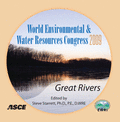Watershed Management in the Indian Himalayan Region: Issues and Challenges
Publication: World Environmental and Water Resources Congress 2009: Great Rivers
Abstract
Indian population constitutes about 15 % of the world's population, whereas its land area and water resources are about 2 % and 4 % of the world's total, respectively. In the last 50 years, the per capita availability of fresh water has been reduced by about 90 %, and the same trend is still going on with the increase in population, urbanization, and industrialization. At the national level, the irrigation alone consumes about 83 % of the available water resources. About 30 % of the total geographical area is drought prone due to erratic pattern of rainfall and out of about 148 million hectare cultivable land about 72 % is rain fed. The economy of the Himalayan region is predominantly agrarian. More than 4/5th of the working population is directly engaged in agriculture. Though Himalayan region gave birth to several perennial rivers and streams, the inhabitants face the problems of drinking water and irrigation. Even though only 12.5% of the total land area is under agriculture, only 11% of the cultivable area is irrigated, almost 64% of which is fed by natural springs. The topography of the region is steep; the average annual rainfall is high (1200–1600 mm) and the soils range from sandy to sandy loam causing very high percolation losses of rainwater from individual farmers' terraced fields. The soil does not hold water for long and consequently in the absence of available soil moisture, the crops suffer badly due to moisture stresses at different stages of crop growth during post-monsoon period. About 60% population in hilly region depends on natural water springs to fulfill their day to day water needs for drinking, sanitation, irrigation etc. About half of the perennial springs have either dried-up or have become seasonal due to ecological imbalance and environmental degradation during last two decades. Nearly 8000 villages mostly located in upper and mid hills have been facing acute shortage of drinking water.
Get full access to this article
View all available purchase options and get full access to this chapter.
Information & Authors
Information
Published In
Copyright
© 2009 American Society of Civil Engineers.
History
Published online: Apr 26, 2012
ASCE Technical Topics:
- Business management
- Climates
- Environmental engineering
- Freight transportation
- Infrastructure
- Irrigation
- Irrigation engineering
- Logistics
- Meteorology
- Population projection
- Practice and Profession
- Precipitation
- Rainfall
- Resource management
- River engineering
- River systems
- Sustainable development
- Transportation engineering
- Urban and regional development
- Water and water resources
- Water management
- Water policy
- Water resources
- Water shortage
- Water supply
- Watersheds
Authors
Metrics & Citations
Metrics
Citations
Download citation
If you have the appropriate software installed, you can download article citation data to the citation manager of your choice. Simply select your manager software from the list below and click Download.
